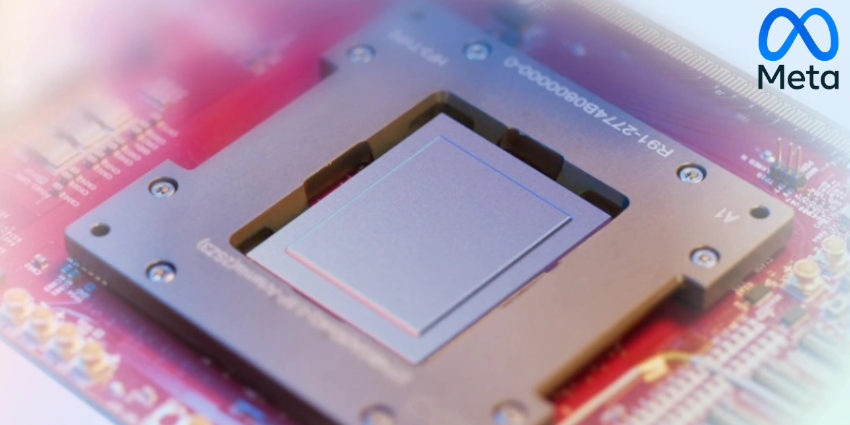Meta Platforms has begun testing its first custom-designed chip for training artificial intelligence models.
This development could be an indication of Meta’s efforts to reduce dependence on external suppliers and control the soaring costs of AI infrastructure.
A Strategic Shift Toward Custom Silicon?
The new AI training chip builds on Meta’s previous work with inference accelerators. In April 2024, Meta unveiled MTIA v2 (Meta Training and Inference Accelerator), which focused primarily on running AI models rather than the more computationally intensive task of training them.
Sources indicate that Meta has initiated a limited deployment of the new chip with plans to expand production if testing proves successful. The chip is reportedly designed as a dedicated accelerator that’s optimized for AI workloads, potentially offering better power efficiency than general-purpose GPUs.
Meta is working with Taiwan-based TSMC on production following the chip’s first “tape-out” – a crucial milestone where an initial design is sent to a factory. This comes as Meta forecasts 2025 expenses between $114-119 billion, with up to $65 billion allocated to capital expenditures.
Industry-Wide Push for Hardware Independence
Meta isn’t alone in pursuing silicon independence. OpenAI is finalizing designs for its own AI accelerator chip, also partnering with TSMC. Led by Richard Ho, a former Google AI chip developer, OpenAI’s initiative reportedly has a budget of approximately $500 million.
These developments reflect growing concerns about dependency on NVIDIA, which currently controls roughly 80% of the AI chip market. Individual NVIDIA H100 chips reportedly cost between $16,000-$100,000, creating enormous expenses for companies building large AI systems.
NVIDIA’s Market Challenges
It was recently revealed that NVIDIA’s GPU computing power has doubled approximately every 10 months since 2019. However, this dominance is increasingly under threat.
Epoch AI’s thorough analysis of NVIDIA’s GPU shipments since 2018 revealed that “NVIDIA GPUs have doubled in computing power every 10 months on average, since 2019.” This means NVIDIA’s total installed compute power has grown more than two times per year.
Their research leveraged NVIDIA financial report data along with a comprehensive dataset covering more than 700 AI data centers, allowing them to track the relative quantities of each GPU model as they come into operation.
In January 2025, DeepSeek’s new AI capabilities reportedly triggered NVIDIA’s largest single-day market value loss in history.
The company’s shares fell by 17%, erasing nearly $600 billion in market value and affecting other tech giants including Alphabet, Microsoft, and Dell Technologies. This dramatic market reaction brought NVIDIA’s stock price back to levels not seen since October 2024, demonstrating the fragility of its market position despite years of dominance.
Research indicates frontier AI model training requirements are expanding 4-5 times annually, creating potential bottlenecks as hardware development advances at a comparatively modest pace.
Meta’s Broader AI Ambitions
Meta’s chip development aligns with reports of planned investments in AI data centers worth approximately $200 billion, potentially in Louisiana, Wyoming, or Texas. This follows previous investments in undersea cabling and existing AI facilities across the United States.
Meta CTO Andrew Bosworth recently emphasized AI as a “core technology” for the company, describing 2025 as “the most critical year” in his eight years at Reality Labs. In an internal memo that emphasized the significance of this year, Bosworth wrote:
We believe that expanding our portfolio to invest in this field will only accrue value to Meta AI and our mixed and augmented reality programs.
He further stressed the critical nature of this period, noting that “This year will likely determine whether our efforts are seen as the work of visionaries or a legendary misadventure.” Bosworth was candid about the company’s position:
We haven’t actually made a dent in the world yet. [However] on paper, 2024 was our most successful year to date.
While Meta pursues aggressive AI development in the US, the company faces greater regulatory challenges in Europe.
Chris Yiu, Meta’s Director of Public Policy, recently explained at an event in Stockholm that “European regulation around technology has its issues, and sometimes it’s too fragmented, like GDPR, sometimes it goes too far, like the AI Act. But the net result of all of that is that products get delayed or get watered down and European citizens and consumers suffer.”
More Options for Enterprise AI?
For enterprise AI customers, the entry of major technology companies into chip development could eventually create more diverse hardware options and potentially more cost-effective solutions. This diversification might reduce dependency on a single supplier and drive innovation in specialized hardware tailored to different AI workloads.
However, Meta has reportedly faced setbacks in previous chip development efforts, including scrapping an earlier inference chip after disappointing test results. While executives hope to implement their own chips for AI training by 2026, Meta continues to be one of NVIDIA’s biggest customers, having aimed to acquire 350,000 H100 chips in 2024 alone.
The new training chip aims to first enhance Meta’s recommendation systems before expanding to power more advanced generative AI applications like Meta AI. As the industry evolves, these hardware initiatives could reshape the competitive dynamics of AI development for years to come.
With companies like Meta, OpenAI, and potentially others developing custom silicon, the AI hardware landscape is becoming increasingly diverse. This shift may eventually benefit enterprise customers through increased competition and specialized solutions, though NVIDIA’s technological advantage remains significant in the near term.







